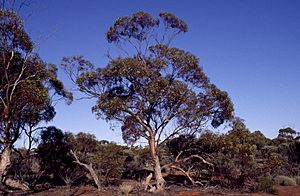Yorrel facts for kids
Quick facts for kids Yorrel |
|
|---|---|
 |
|
| Eucalyptus yilgarnensis near Lake Minigwal in the Great Victoria Desert | |
| Scientific classification | |
| Genus: |
Eucalyptus
|
| Species: |
yilgarnensis
|
The Yorrell (scientific name: Eucalyptus yilgarnensis) is a special type of plant. It's usually a mallee, which means it's a small, bushy tree with many stems growing from the ground. Sometimes, it can grow into a small tree. This plant is found only in Western Australia, making it endemic to that area. Yorrell trees often have rough bark on their main trunk and smooth bark higher up. Their leaves are long and narrow. They have white flowers that grow in small groups, and their fruit looks like a tiny barrel.
Contents
What Yorrell Looks Like
The Yorrell is a mallee or a small tree. It can grow up to 10 m (33 ft) (about 33 feet) tall. It has a special woody swelling at its base called a lignotuber. This helps the plant regrow after fires or damage.
Most Yorrell trees have rough, brown bark on their main trunk. Higher up, the bark is smooth and can be grey or brown. Sometimes, the whole tree has smooth bark.
Leaves and Flowers
Young Yorrell plants have dull, bluish-grey leaves. These leaves can be narrow, oval, or egg-shaped. They are about 40–70 mm (1.6–2.8 in) long and 10–23 mm (0.39–0.91 in) wide. They also have a small stalk, which means they are petiolate.
Adult leaves are shiny green on both sides. They are long and narrow, like a spear or a very thin oval. These leaves are about 50–80 mm (2.0–3.1 in) long and 5–15 mm (0.20–0.59 in) wide. They have a stalk that is 5–25 mm (0.20–0.98 in) long.
The Yorrell's flowers grow in groups of seven or nine. They appear where the leaves meet the stem, which is called the leaf axil. Each group of flowers grows on a stalk called a peduncle, which is 4–15 mm (0.16–0.59 in) long. Each individual flower bud has its own tiny stalk, called a pedicel, about 2–6 mm (0.079–0.236 in) long.
Flower Buds and Fruit
Before they open, the flower buds are oval or pear-shaped. They are about 3–6 mm (0.12–0.24 in) long and 2–3 mm (0.079–0.118 in) wide. Each bud has a cap on top called an operculum. This cap is usually rounded or cone-shaped and about 1–2 mm (0.039–0.079 in) long.
Yorrell flowers are white and bloom from April to November. After flowering, the plant produces fruit. The fruit is a woody, barrel-shaped capsule. It's about 4–6 mm (0.16–0.24 in) long and 3–4 mm (0.12–0.16 in) wide. The parts that open to release seeds are below the rim of the capsule.
How Yorrell Got Its Name
The Yorrell was first officially described in 1919 by a scientist named Joseph Maiden. He wrote about it in a science journal. At first, he called it Eucalyptus gracilis var. yilgarnensis.
Later, in 1986, another scientist named Ian Brooker changed its name. He decided it was different enough to be its own species. So, he gave it the name E. yilgarnensis, which is what we call it today.
Where Yorrell Lives
The Yorrell grows in sandy soil in Western Australia. It is found in open woodlands, which are forests where the trees are not too close together. You can find it in an area between places like Wongan Hills, Kalgoorlie, Zanthus, Balladonia, and Salmon Gums.
Other trees that often grow near Yorrell include Eucalyptus salubris and Eucalyptus salmonophloia. Sometimes, you might also see Eucalyptus melanoxylon and Eucalyptus oleosa growing nearby.
Smaller plants and shrubs that grow under the Yorrell trees include Acacia colletioides, Atriplex vesicaria, Atriplex paludosa, Melaleuca hamulosa, Regelia cymbifolia, Exocarpos aphyllus, and Grevillea acuaria.
Is Yorrell Protected?
The Western Australian Government's Department of Parks and Wildlife has looked at the Yorrell. They have classified it as "not threatened." This means there are enough Yorrell plants in the wild, and they are not currently in danger of disappearing.

